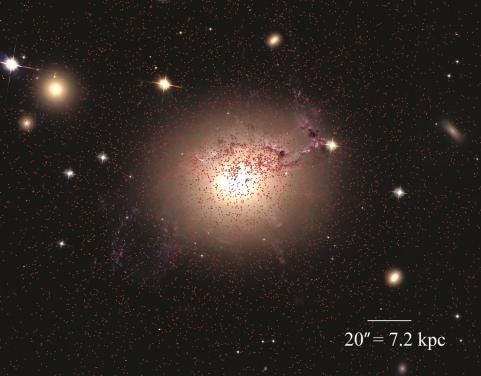
Astronomers believe that globular clusters — found around giant galaxies in the centre of galactic clusters — are ancient relics remaining from the earliest formative stages of galaxies. But, despite this well-founded belief, the physical origins of these clusters — most common around elliptical galaxies — remains something of a mystery.
New research conducted by Dr Jeremy Lim and his Research Assistant, Miss Emily Wong, at the Department of Physics of The University of Hong Kong (HKU) have used data collected by the Hubble Space Telescope in order to find a surprising answer to this cosmic conundrum.
Dr Lim’s team discovered that globular clusters around the giant galaxy at the centre of the Perseus galaxy cluster are not all ancient objects. Whilst most globular clusters are believed by scientists to have formed shortly after the Universe began 13.8 billion years ago, a few thousand of the clusters studied by the team seem to have formed over at least the past 1 billion years. Even more, could have possibly formed later in cosmic history the research suggests.
These younger globular clusters seem to be associated with a complex filamentary network of cool gas which extends to the outer reaches of this giant galaxy. This seems to suggest that these clusters were born in this same network. This is significant as this cool gas is thought to have been deposited by the hot gas that infuses the entire Perseus galaxy cluster. The density of this hot gas and thus the rate at which it cools rises in the direction of the galactic cluster’s centre.
After formation, the newly born galactic clusters are no longer bound to the network of cool gas and begin to fall inwards onto the giant galaxies. This can be considered almost analogous to raindrops condensing in clouds and falling to the ground.

This inward gathering of younger globular clusters after formation in a network of cool gas is in stark contrast to the formation and dispersion of more ancient globular clusters.
These older clusters form from gas compressed in the spiral arms of galaxies or from dense gas at the centre of galaxy clusters. After their formation, the random dispersion of older clusters across the giant galaxy is a result of them scattering off each other during the course of their orbit around this galaxy.
Solving lingering puzzles regarding globular clusters
Globular clusters can contain anywhere from hundreds of thousands to several million stars — all of which are born at the same time. These stars are packed incredibly densely, with the clusters having spherical volumes thousands of times smaller than the diameter of our galaxy — the milky way.
One puzzling aspect of these clusters has been the sheer numbers at which they exist — and how they could have formed at the same point in cosmic history. By showing that some of these clusters form later than others and fall into place — this new research may have solved that puzzle.
Another puzzling aspect of these global clusters is the broad range of colours they display around giant galaxies. Again, this could be a result of the clusters have different respective ages. Globular clusters likely change from blue to red as they age. This is a result of more massive stars burning through their fuel more quickly as nucleosynthesis progresses more quickly in larger stars. As these stars are bluer than smaller stars, as they die it leaves the cluster to take a redder hue. Thus, a broad range of ages would result in a broad range of colours — which is indeed what astronomers observe.
The team’s research does indicate that despite forming at different times, both older and younger globular clusters in the Perseus galaxy share a common formation mechanism. Irrespective of age, the globular clusters span a broad range of masses — with fewer at the larger mass end of the spectrum. This similar mass trend suggests a common formation mechanism for star clusters across the mass scale regardless of the environment in which they formed.
This sustained formation of globular clusters over a long range of time could also explain the enormous size of giant galaxies — which can be in excess of ten times that of the Milky Way. As more massive globular clusters within these galaxies endure, their more diminutive counterparts could be ripped apart during their orbits. This leaves the stars which form these smaller globular clusters to be spread through the giant galaxies contributing to their growth in size.
Original research: ‘Sustained Formation of Progenitor Globular Clusters in a Giant Elliptical Galaxy’ by Jeremy Lim, Emily Wong, Youichi Ohyama, Tom Broadhurst & Elinor Medezinski in Nature Astronomy.






